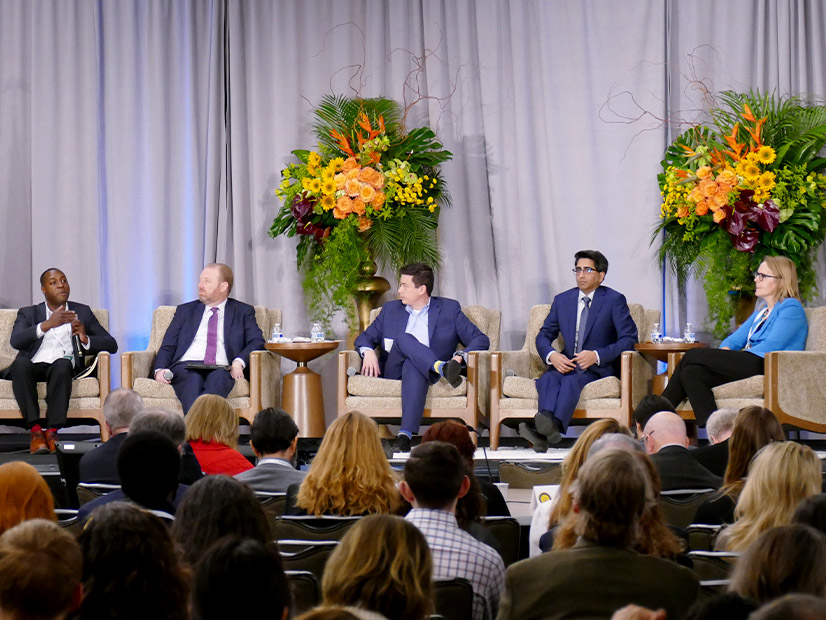
The U.S. used to be able to build massive infrastructure projects such as the Empire State Building and the Pentagon in just a year, but nearly a century later that is far from the case with electric transmission, Maryland Public Service Commission Chairman Jason Stanek said at the National Association of Regulatory Utility Commissioners’ Winter Policy Summit on Monday.
With billions in dollars in new federal incentives aimed at expanding clean energy, the pace of transmission development needs to speed up in order to take full advantage of those.
“As a state commissioner, I’m disappointed,” Stanek said. “I’m disappointed that over my five years at the commission, I haven’t been able to site and build 1 inch of interstate transmission.”
The Inflation Reduction Act and the Infrastructure Investment and Jobs Act (IIJA) are setting the country on course for the largest investment in infrastructure installation in 100 years, said Jeff Dennis, deputy director of the U.S. Department of Energy’s Grid Deployment Office.
“But we know that a significant portion of those benefits — as much as 80%, according to a Princeton study — of the emission reduction benefits that Congress expected from the IRA won’t happen if we don’t increase the pace at which we build transmission,” Dennis said.
The past decade has seen the grid expand at a clip of about 1% per year, but that needs to exceed 2% to meet those goals, he added.
Much of the funding DOE received for transmission in those recent laws is for “commercial support” rather than the loans it has used most often in the past, said Dennis. The money will help finance and speed up the development of transmission.
The IIJA included $2.5 billion the department can use to facilitate transmission by doing things like becoming the anchor-customer on a line to help it get financed and then sell off that space as the project is developed. The IRA has another $2 billion that DOE can use to help support transmission projects deemed in the national interest, Dennis said.
DOE also has new loan authorities, including some aimed at repowering existing corridors so that they can transmit more energy than they do now, Dennis said.
The IRA offers $100 million for addition regional and interregional transmission lines.
New England is expecting major changes to its grid, as it will have to greatly expand clean energy to meet future demand, which is on pace itself to grow from 25 GW today to 43 GW in the future because of electrification, said Digaunto Chatterjee, vice president of system planning for Eversource Energy.
“The best way to deploy IIJA funds is to surgically address specific transmission upgrades on your system and create new landing sites for offshore wind,” Chatterjee said.
While the industry has a daunting task of expanding its transmission grid and turning over to new sources of generation, it is a job that it has successfully performed in the past, said National Grid Clean Energy Development Director Terron Hill.
“When you think about the 1970s, we had a huge buildout of the transmission network in order to pick up electrification needs and new industries,” said Hill. “We saw the same type of buildout of the transmission network as we transitioned away from oil and coal to natural gas.”
New England has added about 300 MW of renewable energy per year, but to meet its carbon-mitigation goals, the pace of infrastructure development will need to be closer to 3,000 MW, Hill said.
“That is a huge challenge, but it’s a challenge that we can meet,” Hill said. “I was told very early in my career, that if you give engineers and planners a problem to solve, they will come up with the best solutions.”
Part of the solution is getting more efficiency out of the existing transmission grid through the adoption of dynamic line ratings, topology optimization and advanced power flow controls, said Hilary Pearson, vice president of policy for LineVision. The firm’s technology has helped New York wring more transfer capability out of its grid, which has historically been congested in power flowing from west to east and north to south, limiting the amount of load served by clean energy.
“By using dynamic line rating sensors in the western part of the state — very renewable-rich but has constraints and congestion on the system — we’re going to be able to eliminate 320 MW of existing wind energy curtailments, while creating another 190 MW in headroom for new renewable energy projects to be able to come onto the grid,” she said.


